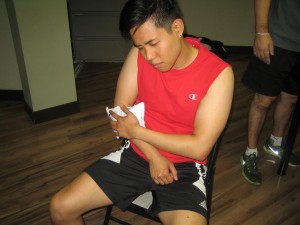The clicking of the elbow while the individual flexes or performs biceps curls simply indicates damage inside the joint. The clicking can be accompanied by swelling, pain and stiffness of the joint. The possible risk factors usually include instability of the joint, previous injuries to the elbow, overuse and monotonous elbow movements. The conservative treatment measures can help manage the symptoms but surgery might be required to completely eliminate the clicking. It is best to consult a doctor once the symptoms become worse or if the clicking becomes painful for the individual to bear.
How the elbow works
The elbow is composed of the humerus and the two bones of the forearm – radius and ulna. There is cartilage in between these bones at the elbow which helps prevent friction and allow smooth movement of the elbow. The ligaments surrounding the elbow include the ulnar and radial collateral ligaments and responsible for stabilizing the joint.
Why clicking and catching occur?
Once a portion of cartilage or bone separates or torn off, it results to the clicking, catching and locking during the movement of the elbow. If the individual sustained dislocation of the elbow due to a fall, it can cause the cartilage and bone to break off. Once a loose piece of bone does not receive enough blood supply, it is a condition called as osteochondritis dissecans.

In some cases, the condition chondromalacia develops. This involves the fraying of the cartilage. Other conditions such as osteophytes or bone spurs as well as arthritis can lead to the slackening of the cartilage and clicking.
Constant strain
Tennis, baseball and weight training can heighten the risk for injury and clicking of the elbow due to repetitive movement and strain on the elbow. Movements that are repetitive or overuse of the elbow can eventually lead to chondromalacia, loose cartilage and arthritis over time.
If the individual has previous injuries to the elbow such as instability of the joint, tendonitis as well as chronic inflammation and dislocations, the risk for joint degeneration and clicking is increased. Additional risk factors include the arm strength, age and flexibility.
Diagnosing the condition
The conservative treatment includes rest, application of ice and anti-inflammatory medications. If you want to learn more how to provide these measures, click here. The individual should wear an elastic wrap or brace for compression and support. Physical therapy and proper warming up can help reduce the pain and swelling often linked with the clicking. As long as the clicking in the elbow is not painful and the individual has low activity level, the conservative measures are enough.
As for athletes and those who suffer from sore clicking and osteochondritis dissecans, arthroscopic surgery is required. When surgery is carried out, the loose cartilage and bone are taken out and any osteophytes are removed. This will be followed by physical therapy which includes stretching and strengthening exercises to restore the strength and range of motion of the elbow.
